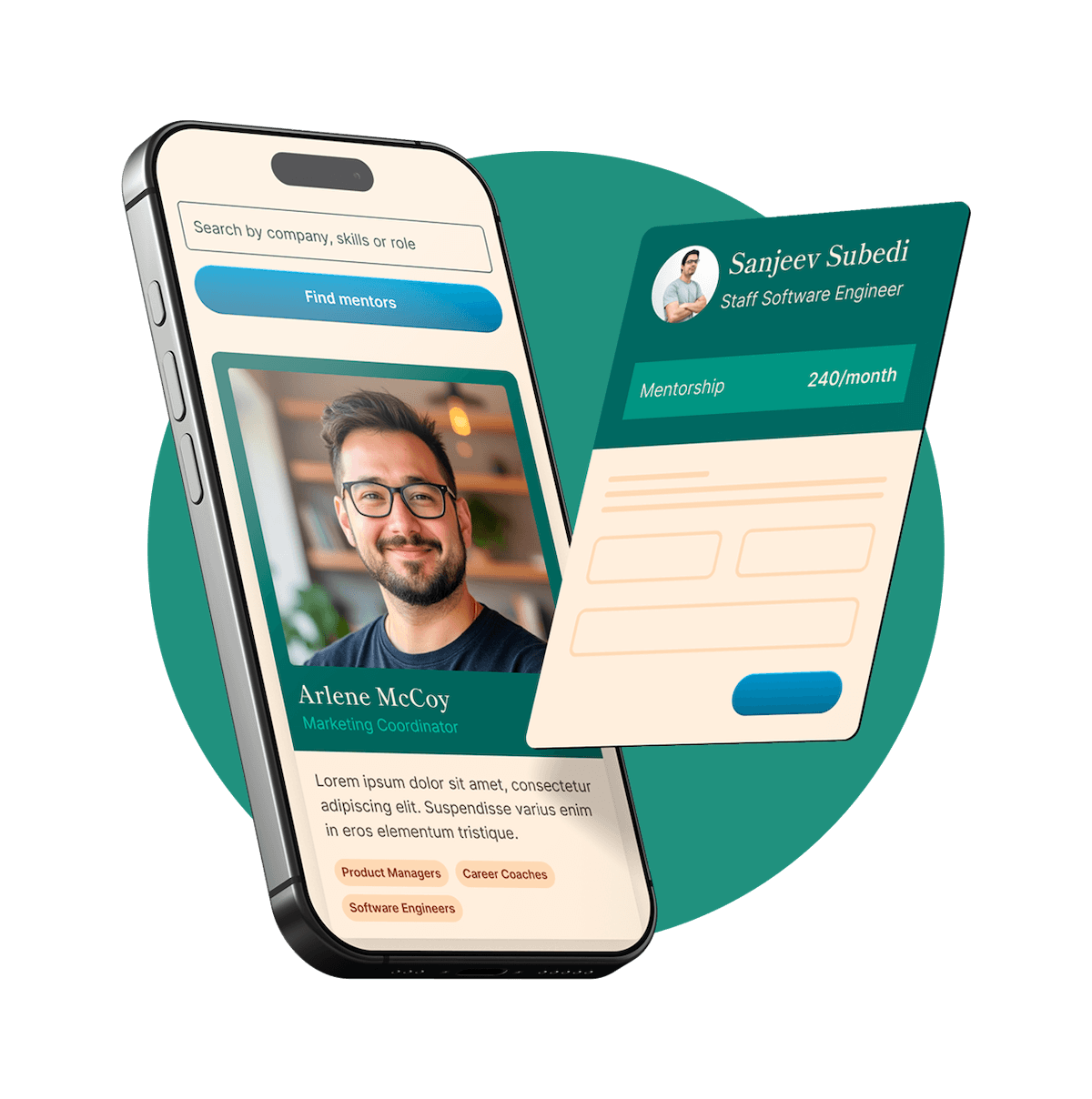I remember the role of "IT" when it meant just fixing printers, installing Windows updates, and troubleshooting office problems.
We're long past that at this point. Tech nowadays is all about the vast ecosystem of creativity, innovation, and—let's be honest—pretty attractive salaries.
There's also the fact that tech isn't going anywhere any time soon, making it a great industry for building a career.
The question is, if you're new to all this, how do you break in?
Do you need an educational or industry background? Maybe you're picturing rooms full of coding prodigies who've been programming since they were 10 and wondering if there's any space for someone who just learned what "HTML" stands for last Tuesday.
Good news: there is.
Plenty of ways in, and that's exactly what this guide is all about. We'll explore the quickest routes, the most in-demand roles, and the best ways to acquire the necessary skills to make your tech transition a reality.
Let's dive in.

Let's get our bearings. The tech industry isn't monolithic. It encompasses a wide range of fields, each with its own unique set of skills and opportunities. It's like a city with different neighborhoods—each with its own culture, language, and entry requirements.
Here's a quick tour of the main districts:
Software development
This is what most people think of when they picture "tech jobs." Software developers build applications for web, mobile, and desktop.
They typically specialize in either front-end (what users see), back-end (server-side logic), or full-stack (both). Languages like JavaScript, Python, and Java are common here.
Data science & analytics
These roles focus on extracting insights from data. If you love patterns, statistics, and making data-driven decisions, this neighborhood might be for you. Skills include SQL, Python, R, and various data visualization tools.
Cybersecurity
With cyber threats on the rise, cybersecurity professionals are the digital security guards. They protect systems, networks, and programs from attacks. This field requires knowledge of network security, ethical hacking, and security protocols.
UX/UI design
The architects of digital experiences. UX (User Experience) designers focus on how products feel, while UI (User Interface) designers focus on how they look. Tools like Figma, Sketch, and Adobe XD are standard here.
Cloud computing
These specialists help organizations move their operations to cloud platforms like AWS, Google Cloud, or Azure. Skills include cloud architecture, containerization, and infrastructure management.
Product management
These roles bridge the gap between technical and business aspects. Product managers define product vision, prioritize features, and coordinate development efforts. This often requires some technical knowledge combined with business acumen.
To identify which sector aligns with your interests, ask yourself:
Explore online resources like Stack Overflow's annual developer survey to see what professionals in different fields do daily.
Better yet, reach out to people working in roles you're curious about (LinkedIn is perfect for this) and ask for a 15-minute informational interview.

There's no "easy button" for breaking into tech. Anyone promising you'll go from zero to six figures in three weeks is selling snake oil. That said, some paths are more direct than others.
Pros: Intensive, focused training; career services; shorter time commitment (typically 3-6 months); structured learning environment.
Cons: High cost (10,000−20,000); fast-paced learning that can be overwhelming; not as universally recognized as degrees.
Bootcamps offer a rapid immersion into specific skills, but they require dedication and a significant time investment. They work best for people who learn well in structured, intensive environments.
Before committing, research placement rates carefully and talk to alumni—not just the success stories featured on their websites.
Pros: Flexible; affordable (many quality options under $50/month); self-paced learning that fits around your current job.
Cons: Lack of structure; requires strong self-discipline; limited career services; no built-in accountability.
Platforms like Udemy, Coursera, and freeCodeCamp provide a flexible and affordable way to learn, but they require strong self-motivation. I recommend these for exploring interests before making bigger commitments or for supplementing other learning methods.
In other words, these are a great starting point for dipping your toe into the industry to see whether it's for you.
Pros: Direct connections to potential employers; practical experience; showcases actual skills rather than just credentials.
Cons: Requires significant initiative; time-consuming; may not lead to immediate employment.
Building a strong portfolio and network can open doors, but it requires consistent effort and proactive engagement. This approach works best when combined with structured learning, not as your sole strategy.
The most effective approach for most career changers is a combination: structured learning (through boot camps or online courses) + portfolio building + strategic networking. This trifecta addresses both skill development and the connections needed to get your foot in the door.
Pro tip: The "quickest" way in often depends on your existing skill set. If you're already adjacent to tech (like in digital marketing or technical writing), you might be able to transition more easily than someone from a completely unrelated field.

Your entry point into tech will depend on your skills, interests, and previous experience. Here are some of the more accessible entry points, especially for career changers:
Use job boards like LinkedIn, Indeed, and specialized platforms like Dice or Stack Overflow Jobs to research roles and their requirements. Pay special attention to the "entry-level" or "junior" positions, and note the common requirements across multiple listings.
Pro tip: Don't just apply to jobs blindly. Look for companies with training programs specifically for career changers or those known for being friendly to non-traditional backgrounds. These often provide better onboarding and support for your transition.

Your educational path will shape your career trajectory, so choose wisely based on your personal circumstances, learning style, and career goals.
Pros: Comprehensive knowledge; strong theoretical foundation; widely recognized credentials; broader career options long-term; structured learning environment; networking with professors and peers.
Cons: Long time commitment; high cost (20,000−100,000+); theoretical focus that may not align with immediate job market needs.
Degrees provide a strong theoretical foundation, but they require a significant time and financial investment. Computer Science degrees remain the gold standard for many employers, but alternative paths have gained increasing acceptance.
If you already have a degree in another field—whether it's Biology, English, or Business—you're not starting from scratch.
Your existing degree demonstrates your ability to learn, think critically, and complete long-term projects. Consider adding targeted tech education rather than pursuing a second bachelor's degree.
Pros: Intensive training focused on job-ready skills; career services and employer connections; shorter time commitment; cohort-based learning and networking.
Cons: High cost (10,000−20,000); fast-paced learning that can be overwhelming; varied quality across programs; narrower focus than degrees.
Bootcamps offer rapid skill acquisition, but they require intense focus and a significant financial commitment. They excel at teaching practical, job-oriented skills but may not provide the same depth of understanding as longer programs.
When evaluating bootcamps, look beyond their marketing claims. Check:
Pros: Flexible; affordable; self-paced learning; ability to focus precisely on what you need.
Cons: Lack of structure; requires exceptional self-discipline; no built-in accountability; no formal credentials; limited career services.
Self-learning provides flexibility and affordability, but it requires strong self-motivation and discipline. This path works well for highly motivated learners who can create their own structure and accountability systems.
If you choose this route, create a concrete plan with:
If you have a Biology degree, for example, your scientific background is a significant asset. You already understand research methods, critical thinking, and complex systems.
Consider fields like bioinformatics, health tech, or data science applied to biological problems. These intersection points leverage your existing knowledge while adding tech skills.
Whatever educational path you choose, complement it with practical projects that demonstrate your skills to potential employers. Theory alone won't get you hired—you need to show what you can actually build or create.

Your portfolio and network are your most valuable assets in the tech job hunt—especially as a career changer without traditional credentials or experience.
Your portfolio should showcase your skills through real-world projects, not just tutorials or exercises. Here's how to build an impressive one:
Your GitHub profile (for developers) or portfolio website should be polished and professional. Quality trumps quantity—three excellent projects are better than ten mediocre ones.
In tech, who you know often determines which opportunities you discover. Effective networking includes:
Remember that networking isn't just about asking for jobs—it's about building genuine relationships. Offer value where you can, whether it's sharing an interesting article or making a relevant introduction.
The tech industry constantly evolves, so continuous learning isn't optional—it's essential for staying relevant. Today's hot framework might be obsolete in five years.
Stay up-to-date with industry trends through:
More importantly, cultivate a growth mindset that embraces challenges as learning opportunities. The most successful tech professionals are those who:
As a career changer, your ability to learn quickly is one of your greatest assets. Document your learning journey—it demonstrates your adaptability and passion to potential employers.
Breaking into tech isn't easy, but it's absolutely achievable with the right approach. Your non-technical background isn't just something to overcome—it's a potential competitive advantage that brings unique perspectives to tech companies.
Your strategy should combine structured learning, practical projects, and strategic networking. Be realistic about the effort required, but don't let that deter you from starting.
Ready to accelerate your tech journey?
Connect with mentors at MentorCruise who've built careers at Google, Amazon, and Microsoft. These industry veterans know exactly what hiring managers look for because they've been in those rooms.
Whether you need personalized learning roadmaps, portfolio reviews, or mock interviews, having a dedicated mentor can cut months off your learning curve and help you avoid costly mistakes.
The tech industry needs diverse experiences. Take action today: visit MentorCruise and find the mentor who will transform your tech career journey.
Find out if MentorCruise is a good fit for you – fast, free, and no pressure.
Tell us about your goals
See how mentorship compares to other options
Preview your first month
